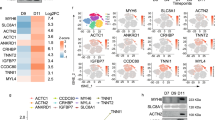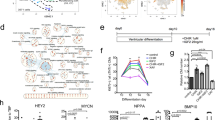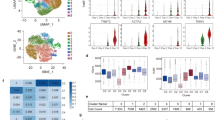Abstract
Cardiomyocytes derived from pluripotent stem cells can be applied in drug testing, disease modeling and cell-based therapy. However, without procardiogenic growth factors, the efficiency of cardiomyogenesis from pluripotent stem cells is usually low and the resulting cardiomyocyte population is heterogeneous. Here, we demonstrate that induced pluripotent stem cells (iPSCs) can be derived from murine ventricular myocytes (VMs), and consistent with other reports of iPSCs derived from various somatic cell types, VM-derived iPSCs (ViPSCs) exhibit a markedly higher propensity to spontaneously differentiate into beating cardiomyocytes as compared to genetically matched embryonic stem cells (ESCs) or iPSCs derived from tail-tip fibroblasts. Strikingly, the majority of ViPSC-derived cardiomyocytes display a ventricular phenotype. The enhanced ventricular myogenesis in ViPSCs is mediated via increased numbers of cardiovascular progenitors at early stages of differentiation. In order to investigate the mechanism of enhanced ventricular myogenesis from ViPSCs, we performed global gene expression and DNA methylation analysis, which revealed a distinct epigenetic signature that may be involved in specifying the VM fate in pluripotent stem cells.
Similar content being viewed by others
Log in or create a free account to read this content
Gain free access to this article, as well as selected content from this journal and more on nature.com
or
References
Yoshida Y, Yamanaka S . Recent stem cell advances: induced pluripotent stem cells for disease modeling and stem cell-based regeneration. Circulation 2010; 122:80–87.
Efe JA, Hilcove S, Kim J, et al. Conversion of mouse fibroblasts into cardiomyocytes using a direct reprogramming strategy. Nat Cell Biol 2011; 13:215–222.
Ieda M, Fu JD, Delgado-Olguin P, et al. Direct reprogramming of fibroblasts into functional cardiomyocytes by defined factors. Cell 2010; 142:375–386.
Laflamme MA, Murry CE . Regenerating the heart. Nat Biotechnol 2005; 23:845–856.
Mauritz C, Schwanke K, Reppel M, et al. Generation of functional murine cardiac myocytes from induced pluripotent stem cells. Circulation 2008; 118:507–517.
Narazaki G, Uosaki H, Teranishi M, et al. Directed and systematic differentiation of cardiovascular cells from mouse induced pluripotent stem cells. Circulation 2008; 118:498–506.
Epstein JA . Franklin H . Epstein Lecture. Cardiac development and implications for heart disease. N Engl J Med 2010; 363:1638–1647.
Ng SY, Wong CK, Tsang SY . Differential gene expressions in atrial and ventricular myocytes: insights into the road of applying embryonic stem cell-derived cardiomyocytes for future therapies. American J Physiol Cell Physiol 2010; 299:1234–1249.
He JQ, Ma Y, Lee Y, Thomson JA, Kamp TJ . Human embryonic stem cells develop into multiple types of cardiac myocytes: action potential characterization. Circ Res 2003; 93:32–39.
Moore JC, Fu J, Chan YC, et al. Distinct cardiogenic preferences of two human embryonic stem cell (hESC) lines are imprinted in their proteomes in the pluripotent state. Biochem Biophys Res Commun 2008; 372:553–558.
Bar-Nur O, Russ HA, Efrat S, Benvenisty N . Epigenetic memory and preferential lineage-specific differentiation in induced pluripotent stem cells derived from human pancreatic islet Beta cells. Cell Stem Cell 2011; 9:17–23.
Kim K, Doi A, Wen B, et al. Epigenetic memory in induced pluripotent stem cells. Nature 2010; 467:285–290.
Lister R, Pelizzola M, Kida YS, et al. Hotspots of aberrant epigenomic reprogramming in human induced pluripotent stem cells. Nature 2011; 471:68–73.
Ohi Y, Qin H, Hong C, et al. Incomplete DNA methylation underlies a transcriptional memory of somatic cells in human iPS cells. Nat Cell Biol 2011; 13:541–549.
Polo JM, Liu S, Figueroa ME, et al. Cell type of origin influences the molecular and functional properties of mouse induced pluripotent stem cells. Nat Biotechnol 2010; 28:848–855.
Stadtfeld M, Maherali N, Breault DT, Hochedlinger K . Defining molecular cornerstones during fibroblast to iPS cell reprogramming in mouse. Cell Stem Cell 2008; 2:230–240.
Wernig M, Lengner CJ, Hanna J, et al. A drug-inducible transgenic system for direct reprogramming of multiple somatic cell types. Nat Biotechnol 2008; 26:916–924.
Chen J, Kubalak SW, Minamisawa S, et al. Selective requirement of myosin light chain 2v in embryonic heart function. J Biol Chem 1998; 273:1252–1256.
Srinivas S, Watanabe T, Lin CS, et al. Cre reporter strains produced by targeted insertion of EYFP and ECFP into the ROSA26 locus. BMC Dev Biol 2001; 1:4.
Hochedlinger K, Yamada Y, Beard C, Jaenisch R . Ectopic expression of Oct-4 blocks progenitor-cell differentiation and causes dysplasia in epithelial tissues. Cell 2005; 121:465–477.
Qyang Y, Martin-Puig S, Chiravuri M, et al. The renewal and differentiation of Isl1+ cardiovascular progenitors are controlled by a Wnt/beta-catenin pathway. Cell Stem Cell 2007; 1:165–179.
Domian IJ, Chiravuri M, van der Meer P, et al. Generation of functional ventricular heart muscle from mouse ventricular progenitor cells. Science 2009; 326:426–429.
Laflamme MA, Chen KY, Naumova AV, et al. Cardiomyocytes derived from human embryonic stem cells in pro-survival factors enhance function of infarcted rat hearts. Nat Biotechnol 2007; 25:1015–1024.
Fijnvandraat AC, Lekanne Deprez RH, Moorman AF . Development of heart muscle-cell diversity: a help or a hindrance for phenotyping embryonic stem cell-derived cardiomyocytes. Cardiovasc Res 2003; 58:303–312.
Fu JD, Jiang P, Rushing S, et al. Na+/Ca2+ exchanger is a determinant of excitation-contraction coupling in human embryonic stem cell-derived ventricular cardiomyocytes. Stem Cells Dev 2010; 19:773–782.
Mummery C, Ward-van Oostwaard D, Doevendans P, et al. Differentiation of human embryonic stem cells to cardiomyocytes: role of coculture with visceral endoderm-like cells. Circulation 2003; 107:2733–2740.
Laugwitz KL, Moretti A, Caron L, Nakano A, Chien KR . Islet1 cardiovascular progenitors: a single source for heart lineages? Development 2008; 135:193–205.
Wu SM, Fujiwara Y, Cibulsky SM, et al. Developmental origin of a bipotential myocardial and smooth muscle cell precursor in the mammalian heart. Cell 2006; 127:1137–1150.
Meissner A, Mikkelsen TS, Gu H, et al. Genome-scale DNA methylation maps of pluripotent and differentiated cells. Nature 2008; 454:766–770.
Bao ZZ, Bruneau BG, Seidman JG, Seidman CE, Cepko CL . Regulation of chamber-specific gene expression in the developing heart by Irx4. Science 1999; 283:1161–1164.
Hu Q, Friedrich AM, Johnson LV, Clegg DO . Memory in induced pluripotent stem cells: reprogrammed human retinal-pigmented epithelial cells show tendency for spontaneous redifferentiation. Stem Cells 2010; 28:1981–1991.
Oh H, Bradfute SB, Gallardo TD, et al. Cardiac progenitor cells from adult myocardium: homing, differentiation, and fusion after infarction. Proc Natl Acad Sci USA 2003; 100:12313–12318.
Chiu CP, Blau HM . 5-Azacytidine permits gene activation in a previously noninducible cell type. Cell 1985; 40:417–424.
Palacios D, Puri PL . The epigenetic network regulating muscle development and regeneration. J Cell Physiol 2006; 207:1–11.
Nagy A, Gertsenstein M, Vintersten K, Behringer R . Detection and analysis of mouse genome alterations and specific sequences. Manipulating the mouse embryo (3rd edition). Cold Spring Harbor Laboratory Press: New York 2003:534–539.
Bock C, Kiskinis E, Verstappen G, et al. Reference maps of human ES and iPS cell variation enable high-throughput characterization of pluripotent cell lines. Cell 2011; 144:439–452.
Li H, Ruan J, Durbin R . Mapping short DNA sequencing reads and calling variants using mapping quality scores. Genome Res 2008; 18:1851–1858.
Gu H, Bock C, Mikkelsen TS, et al. Genome-scale DNA methylation mapping of clinical samples at single-nucleotide resolution. Nat Methods 2010; 7:133–136.
Acknowledgements
We would like to thank Laura Prickett-Rice, Kat Folz-Donahue, and Sutanuka Lahiri of the Harvard Stem Cell Institute Flow Cytometry Core Facility for assistance with FACS analysis, Chuang Du of the Tufts Electrophysiology Core for assistance with electrophysiology recordings, Jie Zhao and members of the Wellman Photopathology Core for assistance with histology, Patricia Follett for assistance with blastocyst injections, and Elizabeth Bearrick for assistance with experiments. We would like to thank Konrad Hochedlinger (Massachusetts General Hospital, Harvard University, USA) for sharing the Rosa26rtTA/rtTA mouse line as well as the lentiviral constructs for iPSC derivation. We would like to thank Lei Bu, Emil Hansson, members of the Chien laboratory, and Konrad Hochedlinger for helpful discussion. HX is supported by Massachusetts General Hospital Executive Committee of Research Fund for Medical Discovery. BAY has received support under NIH Training Grant (5T32HL007208-32) and the MGH ECOR Fund for Medical Discovery. HW is supported by a Jane Coffin Childs postdoctoral fellowship. KOL holds a Croucher Foundation Fellowship. This work is partially funded by GlaxoSmithKline Pharmaceuticals.
Author information
Authors and Affiliations
Corresponding author
Additional information
( Supplementary information is linked to the online version of the paper on the Cell Research website.)
Supplementary information
Supplementary information, Figure S1
Characterization of iPSCs from ventricular myocytes and tail tip fibroblasts. (PDF 204 kb)
Supplementary information, Figure S2
A higher cardiomyogenic potential of ViPSCs than ESCs and TiPSCs (passage 8). (PDF 67 kb)
Supplementary information, Table S1
Genes that may have directed the preferential differentiation of ViPSCs toward ventricular myocytes. (PDF 48 kb)
Rights and permissions
About this article
Cite this article
Xu, H., Yi, B., Wu, H. et al. Highly efficient derivation of ventricular cardiomyocytes from induced pluripotent stem cells with a distinct epigenetic signature. Cell Res 22, 142–154 (2012). https://doi.org/10.1038/cr.2011.171
Received:
Revised:
Accepted:
Published:
Issue date:
DOI: https://doi.org/10.1038/cr.2011.171
Keywords
This article is cited by
-
The march of pluripotent stem cells in cardiovascular regenerative medicine
Stem Cell Research & Therapy (2018)
-
Cord blood cell-derived iPSCs as a new candidate for chondrogenic differentiation and cartilage regeneration
Stem Cell Research & Therapy (2017)
-
Epigenomic Reprogramming of Adult Cardiomyocyte-Derived Cardiac Progenitor Cells
Scientific Reports (2015)
-
On the road to bioartificial organs
Pflügers Archiv - European Journal of Physiology (2014)
-
The Current Status of iPS Cells in Cardiac Research and Their Potential for Tissue Engineering and Regenerative Medicine
Stem Cell Reviews and Reports (2014)



